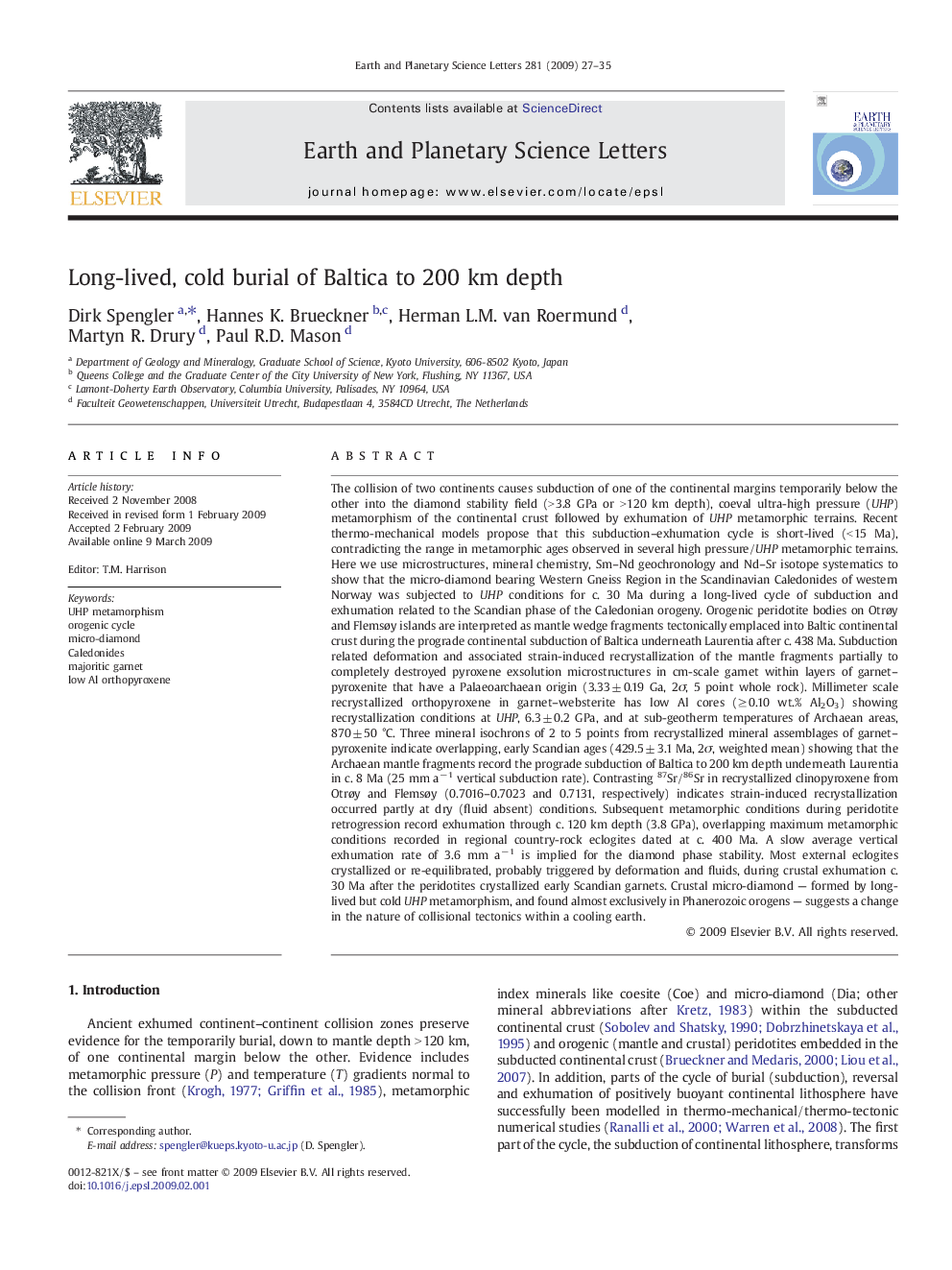| کد مقاله | کد نشریه | سال انتشار | مقاله انگلیسی | نسخه تمام متن |
|---|---|---|---|---|
| 4679224 | 1634875 | 2009 | 9 صفحه PDF | دانلود رایگان |

The collision of two continents causes subduction of one of the continental margins temporarily below the other into the diamond stability field (> 3.8 GPa or > 120 km depth), coeval ultra-high pressure (UHP) metamorphism of the continental crust followed by exhumation of UHP metamorphic terrains. Recent thermo-mechanical models propose that this subduction–exhumation cycle is short-lived (< 15 Ma), contradicting the range in metamorphic ages observed in several high pressure/UHP metamorphic terrains. Here we use microstructures, mineral chemistry, Sm–Nd geochronology and Nd–Sr isotope systematics to show that the micro-diamond bearing Western Gneiss Region in the Scandinavian Caledonides of western Norway was subjected to UHP conditions for c. 30 Ma during a long-lived cycle of subduction and exhumation related to the Scandian phase of the Caledonian orogeny. Orogenic peridotite bodies on Otrøy and Flemsøy islands are interpreted as mantle wedge fragments tectonically emplaced into Baltic continental crust during the prograde continental subduction of Baltica underneath Laurentia after c. 438 Ma. Subduction related deformation and associated strain-induced recrystallization of the mantle fragments partially to completely destroyed pyroxene exsolution microstructures in cm-scale garnet within layers of garnet–pyroxenite that have a Palaeoarchaean origin (3.33 ± 0.19 Ga, 2σ, 5 point whole rock). Millimeter scale recrystallized orthopyroxene in garnet–websterite has low Al cores (≥ 0.10 wt.% Al2O3) showing recrystallization conditions at UHP, 6.3 ± 0.2 GPa, and at sub-geotherm temperatures of Archaean areas, 870 ± 50 °C. Three mineral isochrons of 2 to 5 points from recrystallized mineral assemblages of garnet–pyroxenite indicate overlapping, early Scandian ages (429.5 ± 3.1 Ma, 2σ, weighted mean) showing that the Archaean mantle fragments record the prograde subduction of Baltica to 200 km depth underneath Laurentia in c. 8 Ma (25 mm a− 1 vertical subduction rate). Contrasting 87Sr/86Sr in recrystallized clinopyroxene from Otrøy and Flemsøy (0.7016–0.7023 and 0.7131, respectively) indicates strain-induced recrystallization occurred partly at dry (fluid absent) conditions. Subsequent metamorphic conditions during peridotite retrogression record exhumation through c. 120 km depth (3.8 GPa), overlapping maximum metamorphic conditions recorded in regional country-rock eclogites dated at c. 400 Ma. A slow average vertical exhumation rate of 3.6 mm a− 1 is implied for the diamond phase stability. Most external eclogites crystallized or re-equilibrated, probably triggered by deformation and fluids, during crustal exhumation c. 30 Ma after the peridotites crystallized early Scandian garnets. Crustal micro-diamond — formed by long-lived but cold UHP metamorphism, and found almost exclusively in Phanerozoic orogens — suggests a change in the nature of collisional tectonics within a cooling earth.
Journal: Earth and Planetary Science Letters - Volume 281, Issues 1–2, 30 April 2009, Pages 27–35